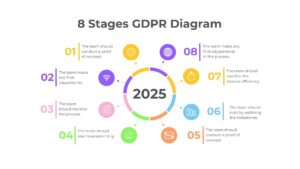
In today’s digital age, data collection has become an integral part of how businesses operate online. From personalizing user experiences to targeted advertising, the data collected from website visitors is invaluable. However, with the introduction of strict data protection regulations like the EU’s General Data Protection Regulation (GDPR) and Switzerland’s Federal Act on Data Protection (FADP), companies must be more transparent and accountable when collecting and processing personal data. This article explores the key aspects of data protection in the context of data collection, focusing on the implications of the GDPR and the FADP.
Understanding Data Protection (GDPR)
Data protection refers to the legal and regulatory framework that governs the collection, storage, processing, and sharing of personal data. Personal data is any information that can identify an individual, such as names, email addresses, phone numbers, and IP addresses. In the digital landscape, where data is constantly being generated and exchanged, robust data protection measures are essential to safeguard individuals’ privacy and rights.
The GDPR: A Comprehensive Framework for Data Protection
The GDPR, which came into effect on May 25, 2018, aims to strengthen and unify data protection for individuals within the European Union. The regulation applies to any organization that processes the personal data of EU residents, regardless of where the organization is based. This extraterritorial scope means that businesses outside the EU must also comply with the GDPR if they handle the data of EU citizens.
Key Principles of the GDPR
The GDPR is built on several key principles that guide data protection practices:
1. Lawfulness, Fairness, and Transparency: Organizations must process personal data lawfully, fairly, and transparently. This means that individuals should be informed about how their data will be used and the legal basis for processing it.
2. Purpose Limitation: Data protection regulations require that personal data be collected for specified, legitimate purposes and not processed in a manner incompatible with those purposes.
3. Data Minimization: Organizations should only collect the minimum amount of personal data necessary to achieve their specified purpose. This principle is crucial for effective data protection.
4. Accuracy: Data protection mandates that personal data must be accurate and kept up to date. Organizations are responsible for rectifying any inaccuracies in a timely manner.
5. Storage Limitation: Personal data should be retained only for as long as necessary to fulfill the purposes for which it was collected. Organizations must establish retention policies to comply with this principle.
6. Integrity and Confidentiality: Data protection requires that organizations implement appropriate security measures to protect personal data against unauthorized access, loss, or damage.
7. Accountability: Organizations must demonstrate compliance with data protection principles and be able to provide evidence of their data protection practices.
The Swiss Data Protection Act (FADP)
While Switzerland is not a member of the European Union, it has its own data protection framework that aligns closely with the GDPR. The FADP was revised in 2020 to strengthen data protection and ensure that Swiss law meets the standards set by the GDPR.
Key Features of the FADP
The FADP shares many similarities with the GDPR, including principles such as consent, transparency, and data subject rights. However, there are some differences worth noting:
1. Scope: The FADP applies to the processing of personal data by private individuals and public authorities, but it has a narrower scope than the GDPR in some respects.
2. Data Protection Officer (DPO):While the GDPR mandates the appointment of a DPO for certain organizations, the FADP does not have a similar requirement. However, organizations are encouraged to appoint a DPO to oversee compliance with data protection laws if it is involved into the risk data processing.
3. Cross-Border Data Transfers: The FADP places restrictions on the transfer of personal data outside of Switzerland, particularly to countries that do not provide adequate data protection. Organizations must ensure that appropriate safeguards are in place for such transfers.
Consent and Transparency in Data Protection
One of the most crucial aspects of both the GDPR and the FADP is the need for clear and unambiguous consent from users before collecting their personal data. This means that pre-ticked boxes or implied consent are no longer sufficient. Websites must provide users with a simple and accessible way to opt-in to data collection, clearly explaining what information is being gathered and for what purpose.
Importance of Informed Consent
Informed consent is a cornerstone of data protection. Organizations must ensure that individuals understand what they are consenting to when providing their data. This includes:
– Clear Language: Privacy notices and consent forms should be written in clear, straightforward language that is easy for users to understand.
– Specificity: Organizations should specify the types of data being collected, the purposes for which the data will be used, and any third parties with whom the data may be shared.
– Granularity: Users should have the option to provide consent for different types of data processing activities, allowing them to make informed choices about their personal information.
Data Minimization and Purpose Limitation in Data Protection
Another key principle of the GDPR and FADP is data minimization, which states that companies should only collect the minimum amount of personal data necessary to achieve their specified purpose. This principle is essential for effective data protection, as it reduces the risk of unnecessary data exposure and potential breaches.
Implementing Data Minimization
Organizations can implement data minimization practices by:
– Conducting Data Audits: Regularly reviewing the types of data being collected and assessing whether all data is necessary for the intended purposes.
– Setting Clear Objectives: Clearly defining the objectives for data collection and ensuring that only data relevant to those objectives is collected.
– Limiting Data Retention: Establishing retention policies that specify how long data will be kept and ensuring that data is deleted when it is no longer needed.
User Rights and Data Subject Access Requests
Both the GDPR and FADP grant individuals certain rights over their personal data, including the right to access, rectify, or delete their information. Websites must have processes in place to handle data subject access requests in a timely manner, typically within one month of receiving the request.
Key User Rights
1. Right to Access: Individuals have the right to request access to their personal data and obtain information about how it is being processed.
2. Right to Rectification: Users can request corrections to their personal data if they believe it is inaccurate or incomplete.
3. Right to Erasure: Also known as the “right to be forgotten,” individuals can request the deletion of their personal data under certain circumstances.
4. Right to Data Portability: Individuals can request to receive their personal data in a structured, commonly used, and machine-readable format, allowing them to transfer it to another service provider.
5. Right to Object: Users have the right to object to the processing of their personal data for specific purposes, such as direct marketing.
Penalties for Non-Compliance
Failure to comply with the GDPR or FADP can result in significant penalties. Under the GDPR, companies can face fines of up to €20 million or 4% of their global annual revenue, whichever is higher. In Switzerland, the FADP allows for fines of up to CHF 250,000 for individuals and CHF 50,000 for companies.
Importance of Compliance with Data Protection regulations
Compliance with data protection regulations is not only a legal obligation but also a critical aspect of maintaining customer trust. Organizations that prioritize data protection demonstrate their commitment to safeguarding user privacy, which can enhance their reputation and foster customer loyalty.
Best Practices for Data Collection and Protection
To ensure compliance with the GDPR and FADP, websites should implement the following best practices:
1. Conduct a Data Audit: Identify what personal data is being collected and where it is stored. This audit should include a review of data sources, storage locations, and processing activities.
2. Create a Clear and Concise Privacy Policy: Draft a privacy policy that outlines what data is collected, how it is used, and how users can exercise their rights. Ensure that the policy is easily accessible on the website.
3. Implement Robust Security Measures: Protect user data from unauthorized access, loss, or breaches by implementing strong security measures, such as encryption, firewalls, and regular security assessments.
4. Train Employees on Data Protection Best Practices: Ensure that all employees understand their responsibilities regarding data protection and are aware of the organization’s policies and procedures.
5. Regularly Review and Update Data Collection Practices: Stay informed about changes in data protection regulations and best practices, and regularly review data collection practices to ensure ongoing compliance.
Conclusion
In conclusion, data collection on the internet is a complex and evolving landscape. The GDPR and Swiss Data Protection Act (FADP) have significantly impacted how businesses collect and process personal data, emphasizing the importance of transparency, consent, and accountability. By prioritizing data protection, organizations can build trust with their customers and avoid costly penalties for non-compliance.
As data protection regulations continue to evolve, businesses must remain vigilant and proactive in their data collection practices. By following best practices and staying informed about regulatory developments, organizations can navigate the complex world of data protection while still leveraging the power of data to drive business success.
In a world where data is increasingly valuable, prioritizing data protection is not just a legal obligation—it is a fundamental aspect of ethical business practices. By fostering a culture of data protection, organizations can ensure that they respect individuals’ rights and contribute to a safer digital environment for everyone.
1. References
1. University of Reading. (n.d.). Data protection issues for references. Retrieved from [University of Reading](https://www.reading.ac.uk/imps/data-protection/data-protection-additional-information/introduction-to-references/checklist-for-writing-references/data-protection-issues-for-references)
2. Prettys Solicitors. (n.d.). Data Protection and Employment References. Retrieved from [Prettys Solicitors](https://www.prettys.co.uk/newsletters/data-protection-and-employment-references)
3. Setterwalls. (n.d.). GDPR and reference checking: What to consider and the benefits of a digital workflow. Retrieved from [Setterwalls](https://www.refapp.com/blog/gdpr-and-reference-checking-what-to-consider-and-the-benefits-of-a-digital-workflow)
4. Teavaro. (n.d.). How to collect customer data in compliance with GDPR. Retrieved from [Teavaro](https://blog.teavaro.com/en/blog/collect-customer-data-in-compliance-with-gdpr)
5. Russell HR Consulting. (n.d.). How Should Employers Deal with References Post-GDPR? Retrieved from [Russell HR Consulting](https://russellhrconsulting.co.uk/the-hr-headmistress-blog/how-should-employers-deal-with-references-post-gdpr)
2. Citations:
- Data protection issues for references
- Data Protection and Employment References
- GDPR and reference checking: What to consider and the benefits of a digital workflow
- How to collect customer data in compliance with GDPR
- How Should Employers Deal with References Post-GDPR?
- GDPR: A Step Towards a User-Centric Internet
- How to be GDPR Compliant
- Data Privacy and GDPR in Healthcare




